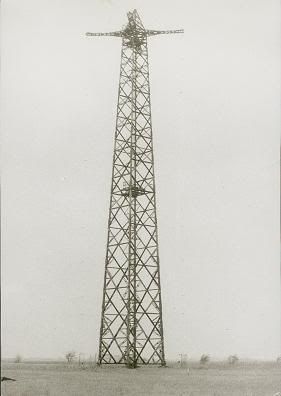The Singing Shilling
In his autobiography, Treading the Loose Boards, the actor and playwright, Malcolm Bevins, writes of his time as a soldier in the British army, during World War II. He recalls, one morning, waking up to find the skies above Normandy filled with silver discs, descending on nylon parachutes and provoking sporadic fire from German air defences - a spectacle that he compares to the unexpected arrival of a fleet of flying saucers.
Bevins had witnessed an airdrop of clockwork-operated seven inch singles – what had become known among the troops as ‘Singing Shillings’, because of their resemblance to silver coins as they tumbled out of the sky. They were one part of multi-faceted initiative by the War Office to keep morale high on the battlefield.
The Singing Shilling was a basic, if ingeniously designed record player constructed around a 7 inch vinyl single. It was housed inside a sealed, circular tin, similar to a film reel canister, roughly 8 inches in diameter and about an inch thick. Around the circumference there was a speaker grill and a small hole for the turning key.
If you prised the canister open, inside you would find a clockwork mechanism, a small speaker, and a vinyl disc with a roving stylus on either side, that was designed to drop down onto whichever surface was upright.
Winding the mechanism had the joint effect of providing enough power for a single play of the disc while also returning the stylus to the beginning of the record. On early models this would entail dragging the needle in reverse through the spiral groove, effectively playing the contents backwards at the same speed as the key was being turned. Later the design was improved, allowing the stylus to be lifted off the platter while winding was in progress and only released once the key had been removed.
The recordings for Singing Shillings were made at a small studio owned and operated by the War Office. They were subsequently pressed and assembled at a factory in what was then the village of Easthampstead. A discography, now viewable though the public records office, lists over 800 titles, typically songs and comedy sketches, intended for allied troops. A small number were recorded in German and used as propaganda. For reasons that remain a mystery, a further 53 titles are currently undisclosed and their details not scheduled to be released into the pubic domain until the year 2015.
My first encounter with Singing Shillings was on my 24th birthday when I was given one as a present. It is a recording of a young lady by the name of Marjorie Cottingham, who in the torn black and white photograph, pasted onto one side of the tin, looks every inch the chaste vicar’s daughter. The A-side is her performance of a song titled: Three Little Birds. The B-side is her spoken rendition of The Lord’s Prayer. The sound is weak – you need to be sitting no more than a few feet from the player to hear the music – and the sentiment decidedly trite, and yet I continue to be fascinated by it. In the intervening years I have expanded my collection to 17 Singing Shillings and would have more if their relative scarcity and growing desirability hadn’t priced me out of the market.
I feel obliged to add one note of warning to any would-be collectors. German forces would often intercept airdrops of Singing Shillings and booby trap them. Some of these booby-trapped devices are most likely still in circulation and so a degree of caution is necessary. There is a video on youtube which clearly demonstrates how to check Singing Shillings for explosives and disarm them if necessary. I have performed the operation a couple of times in my back garden. It is a simple procedure requiring nothing more than a flat-headed screwdriver and a pair of pliers.

